Types of housing
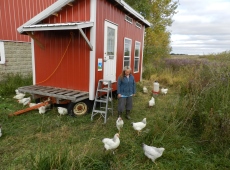
There are many examples of mobile houses, ranging from the “adapted” to the kit form, allowing birds to be moved and integrated into the farm environment as required
Free-range poultry are generally housed in static barns or aviaries with access for the birds to the range through pop-holes, either directly or through an enclosed verandah or in mobile housing. There are a number of housing related issues that influence welfare to be considered, including where the house is sited, the environment within the house, including the ‘furnishings’ such as nest boxes, perches, feeders and drinkers, the litter, access to light and the access to outdoors.
Mobile houses
There are basically two forms of mobile housing: those that are large and are moved between batches and the smaller ark-type houses that are moved more frequently. Ark type houses are limited by their size and are labour intensive. However, they do permit good disease control through frequent rotation. Mobile house systems naturally restrict group size, as there is a practical limit to the size of a house. Mobile systems, particularly on the larger scale, lend themselves more easily to integration into a whole farming system.
Static or fixed houses
Fixed house systems, in which relatively large numbers of birds can be kept, do not lend themselves particularly well to integration with a whole farming system, although there are producers who are able to grow arable crops to support the poultry.
The main advantage of static housing for poultry is that it is easier to find automatic or semi-automatic solutions for the provision of feedstuffs, water and for the collection of eggs and droppings, which means that the costs per bird are likely to be lower. With regard to disease control, static houses do not lend themselves well to paddock systems that enable reduced risk of parasite burdens, particularly helminths. There are also risks involved in the buildup of mud around static houses, which may be carried into houses and cause contamination of birds and fittings, and provide damp conditions that predispose birds to health issues such as footpad dermatitis.
Static houses are normally either floor-based or aviary systems. Floor-based systems are frequently simply covered straw-yards. These systems are normally used for table-bird production.
Building design
Many of the potential problems that can create stress in alternative systems can be eliminated at the design stage (Defra, 2001).
There are a number of good practice points to be considered in the design of buildings for poultry:
• Provision of dry, friable litter.
• Birds should not need to walk more than 3m to find water and food.
• Avoidance of key areas that can be patrolled by bullies.
• No draughts.
• No shafts of light should enter the building.
• Dark areas to be avoided except for nest boxes.
• Vermin-control. Although provision of vermin proof conditions is desirable, this is not really possible to implement under free-range conditions.
• Adherence to housing standards.
• In fixed house situations, either wire mesh or stones in areas immediately outside popholes.
• Finally and most importantly, air quality (i.e. low ammonia levels, correct humidity, correct temperature and good ventilation) plays a crucial role in health management.
House Location
The position of a house can influence ranging activity and bird health. Soil type and drainage are instrumental in determining the extent of build up of soil-borne parasites. Here are some key points to consider with regard to siting of free-range poultry houses, and in particular static houses:
- Locating houses on free draining, south facing pasture can minimise the build-up of internal parasites and coocidial oocysts and can improve grass cover.
- Ideally, houses should be positioned in the centre of the land area so that a series of radiating paddocks can be created around the unit, although this will depend on power and water supplies and subject to local planning constraints.
- Siting houses at right angles to the prevailing wind slightly moderates the amount of wind entering the building through the popholes.
- Accessibility during all weather conditions is an important consideration.
- Range areas bordered by dense woodland are likely to be at greater risk from predation by large mammals.
Litter management
Litter management is a vital component of managing the welfare of birds as ammonia release from poor litter can lead to conditions such as breast blister, hock burn, pododermatitis and respiratory disease. Management of litter in free range systems presents problems, particularly in winter when the weather is cold and litter is likely to become wet.
Three factors are highlighted that have particularly important effects on litter condition: litter moisture, greasy capped litter (resulting from too much fat in the feed or feed of poor quality); and nitrogen in the litter. Several diseases and conditions are known to be associated with poor litter, including malabsorption syndrome, infectious bursal disease, bacterial infections, burnt hocks and pododermatitis.
Stocking density, water provision, depth of litter, type of litter, ventilation, condensation and feed quality are all associated with litter quality. Mouldy litter should not be used.
The U.S. poultry industry has historically used pine shavings as the litter of choice for many years. Sawdust has replaced pine shavings in many areas, however, not by choice, but because pine shavings have become increasingly difficult to obtain. Regionally, rice hulls, straw, and peanut hulls can be found in use by poultry producers for litter. Recycled paper products have received a lot of research and development, but have not had a great deal of acceptance by the poultry industry. Sand is another alternative bedding that is currently being tested in southern climates (from Grimes et al., 2002). Straw is a common bedding material in Europe, although wood shavings provide a better litter substrate (Su et al., 2000).
There is further information on litter management within the disease section. See Footpad dermatitis
Perches
Hens are motivated to use a perch for night-time roosting and they should be housed in systems with perches (Olsson and Keeling, 2002). The provision of perches for laying birds not only satisfies a natural behavioural activity, but can also help increase bone strength (Hughes et al., 1993; Tauson and Abrahamsson, 1994), although this latter point is more likely to be an issue in confined systems. However, if badly designed, perches can also result in pain and injury.
For broiler birds, the period of perching increases with age of bird up to 6 weeks, decreases with hotter temperatures, and tends to be greater for perches with lower angles (0° and 10°). Birds also have a tendency to perch mostly during twilight hours. Perches should be arranged so as to enable birds to easily move between them and other equipment, thus reducing the risk of collisions and subsequent bruising and/or other damage. Birds have difficulty in moving from perch to perch if they are more than 1m apart (Scott and Parker, 1994). To minimise the risk of injury, the angle between perches at different heights should be no more than 45°, and the horizontal and vertical distances between these perches minimised, to allow the birds to be able to move downwards easily (Scott et al., 1997).
Perches should also be sited and placed with consideration to minimising bird stress and downgrading during catching. Having removable perches can aid this process (Defra, 2001). Wet perches, which may occur if the litter is excessively wet, may contribute to the severity of footpad lesions (Wang et al., 1998).
Ventilation
Heat stress in poultry houses can be a problem, and is associated with stocking densities and ventilation. The air quality within the poultry houses can also be unsatisfactory for both the health of the farmer and the bird inhabitants as well as having negative impacts on production . Conditions that promote huddling, such as poorly ventilated buildings, can still result in stress, injury and, in extreme circumstances, death. The negative effects of high and low temperatures can be minimized by appropriate housing design, ventilation and feeding. The use of ceiling fans during periods of hot weather can be a solution to heat stress and lead to a reduction in ammonia levels.
A ventilation system needs to provide uniform, draught free, distribution of air, either using natural forces or through powered fans, so as to ensure air change rate is adequate for the removal of bird heat during hot weather (maximum ventilation rate) and to remove stale, smelly air and humidity during cold weather (minimum ventilation rate) (Defra, 2001). Good ventilation needs to be complemented by good building insulation.
Raised popholes can help in reducing the impact of climatic extremes on the temperature within the house.
· Provide adequate ventilation for the number of birds housed.
· Provide fast air speed over birds.
· High humidity increases the likelihood of heat stress in hot weather.
· Where possible, reduce stocking densities during hot weather both in the shed and during transport.
· Regularly maintain and test alarms and emergency ventilation equipment.
· Make contingency plans in advance so all know their respective roles
· Ensure that someone is available with authority to take actions.
(Defra, 2005)
The welfare of hens in free- range systems (Defra, 2001) above provides guidance on ventilation rates.
Lighting
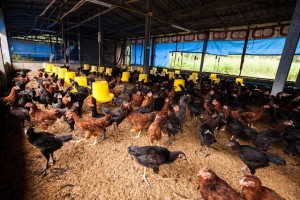 Light is used in commercial poultry production to stimulate egg production in breeding and layer flocks and to influence feeding and hence growth, especially skeletal development, in broiler flocks. The artificial light we provide to housed poultry is different to natural light and tends to ignore the birds light requirements and needs, focusing instead on human welfare and economic efficiency. Failure to provide sufficient light can have negative impacts on welfare, potentially restricting the birds ability to perform natural behaviours, such as feeding and social interaction (Prescott et al., 2003). Light stress is also associated with conditions such as aggression and cannibalism. It is desirable to allow birds as much natural light as is possible, and we recommend a minimum period of 8 hours of continuous nocturnal rest without artificial light. The major difference in performance of chickens housed with and without artificial environmental controls, such as heating, is in feed consumption, particularly during winter.
Light is used in commercial poultry production to stimulate egg production in breeding and layer flocks and to influence feeding and hence growth, especially skeletal development, in broiler flocks. The artificial light we provide to housed poultry is different to natural light and tends to ignore the birds light requirements and needs, focusing instead on human welfare and economic efficiency. Failure to provide sufficient light can have negative impacts on welfare, potentially restricting the birds ability to perform natural behaviours, such as feeding and social interaction (Prescott et al., 2003). Light stress is also associated with conditions such as aggression and cannibalism. It is desirable to allow birds as much natural light as is possible, and we recommend a minimum period of 8 hours of continuous nocturnal rest without artificial light. The major difference in performance of chickens housed with and without artificial environmental controls, such as heating, is in feed consumption, particularly during winter.
Disruption of a lighting regime can cause serious harm to flock development. All lighting programs used with commercial flocks use the principles of decreasing light stimulation for growing pullets and increasing light stimulation after the pullets have reached a mature production age. Light is a very strong stimulating factor in poultry and must be carefully managed.
A general rule of thumb is that pullets should never be subjected to increasing artificial light and layers never subjected to decreasing artificial light. Until the pullets are three weeks old, they should be given 20 to 24 hours of light daily. Gradual changes in artificial lighting are recommended. As well as length of lighting, light intensity is also an important consideration. The provision of light to point of lay and laying birds will depend on season.


 American English
American English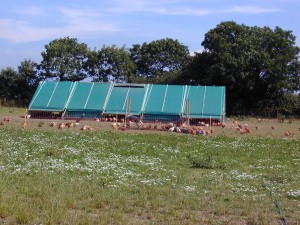
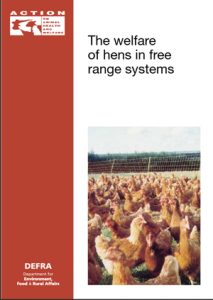
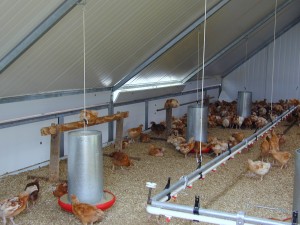
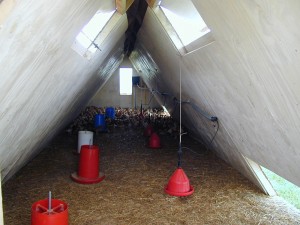


Comments are closed.